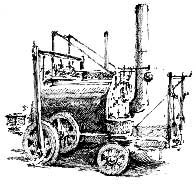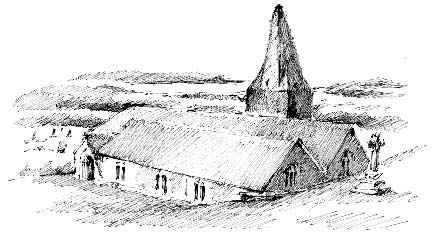Cornwall
KING ARTHUR ∗ CRADLE OF WIRELESS
∗ COME TO GOOD ∗ A CORNISH ECCENTRIC
∗ JIGGING JOGGING EVERYWHERE ∗ PASTY
Gryll’s Gate in Helston, landmark on the route of the ancient Furry Dance.
CORNWALL FOLK
Richard Trevithick ∗ Humphry Davy ∗ Sir John Betjeman ∗ Daphne du Maurier ∗ Arthur Quiller Couch ∗ Rosamund Pilcher ∗ Richard and John Lander
Kernow
Cornwall possesses mainland England’s most southerly point (the Lizard) and most westerly point (Land’s End). Surrounded on three sides by sea, Cornwall, the old kingdom of Kernow, is also England’s most isolated county, and the native population are largely from Celtic stock, as in Wales and Ireland.
King Arthur
Wherever you roam in Cornwall you are never far from KING ARTHUR.
TINTAGEL on the bleak north coast, with its dark cliff-top castle ruins, is where legend says King Arthur was born on a stormy night, after Arthur’s father, King Uther Pendragon, seduced the Duke of Cornwall’s wife Igema, with the help of the wizard Merlin. Even though the 12th-century castle was built 600 years too late, the setting is romantic and persuasive, and there is evidence that the site was used from the 4th century or even earlier. Below the headland, reached by clambering down the rocks to the beach, is a large cave known as Merlin’s Cave, where the wizard is said to have plotted with Uther Pendragon.
Arthur may well have lived in the early 5th century, when the Romans were abandoning Britain and Anglo–Saxon mercenaries were sweeping the remaining Romano–British Celts westwards. A brave Celtic Christian warrior emerged from the west to lead the resistance against the pagan invaders, and had some success in halting their advance, with a famous victory at Mount Badon, thought to be near Bath.
There is no doubt that the legend of King Arthur is based on such a Celtic leader, and Arthur has become a symbol of hope and courage for the English in adversity. In medieval times the warrior Arthur became associated with the code of chivalry brought over from France by the Plantagenet kings (chivalry being derived from the French word ‘chevalier’ meaning knight), and the tale of King Arthur and the Knights of the Round Table fused the soldier with the chevalier to create the definitive British hero, claimed by Welsh and English alike.
The Cradle of Wireless
The world’s first transatlantic radio signals were sent to Newfoundland from Poldhu Cove, on the Lizard, south of Helston. On a bare, windy cliff top near Mullion are the scant remains of the wireless station from where the signals were transmitted on 12 December 1901, using equipment invented by the ‘father of the wireless’ Guglielmo Marconi. Against all the prevailing wisdom Marconi proved that radio waves could be sent over long distances and follow the curvature of the Earth. Radio, television and the internet all owe their existence to this remarkable achievement, and a memorial and museum on the spot tell the story.
Not far away is the GOONHILLY EARTH SATELLITE STATION, BRITAIN’S FIRST EARTH SATELLITE STATION. It was completed in 1962 and exchanged the first intercontinental picture transmissions with the US via a space satellite.
Come to Good
The quaint little thatched Meeting House, embowered in trees and set in a hollow at Come to Good, a hamlet south of Truro, was built in 1710 and is one of the oldest Quaker meeting houses in the world. Come to Good, from the Cornish ‘Cwm Ty Quoit’, means ‘house in the wooded combe’. It is a simple white cob hut lined with plain wooden benches and a small gallery, a friendly place where meetings are still held regularly.
A Cornish Eccentric
Few people wept when the REV FREDERICK DENSHAM, Vicar of Warleggan, on Bodmin Moor, died in 1953. He was known as the rudest clergyman in Cornwall and he was so abusive to his parishioners that for ten years they refused to attend services at the pretty, 15th-century village church. Unbothered, he made himself a congregation of cardboard figures, which he propped up in the pews, and on Sundays would harangue them with fiery sermons. Thought to survive on a diet of nettles and gruel, he got rid of all his furniture in case it was stolen and, just to be doubly sure, encircled the vicarage with barbed wire.
Come to Good Meeting House
Daphne du Maurier is thought to have based the Rev Francis Davey, the mad vicar in her novel Jamaica Inn, on the Rev Densham.
Helston
Dancing here, prancing there, Jigging, jogging everywhere
The HELSTON FURRY DANCE is one of the oldest of all the English festivals, a Cornish-style May Day ritual that celebrates the end of winter and the coming of spring, and has its origins in pagan times. It is always held on 8 May, except when that is a Sunday or Monday, in which case it takes place the previous Saturday. The name ‘Furry’ comes from the old Cornish or Celtic word ‘feur’, meaning festival.
Helson prepares for its big day for weeks beforehand. Houses and public buildings are decorated with spring foliage, bluebells, gorse, sycamore, hazel and laurel; gardens are tidied up, school-children are rehearsed. Then, at 7 a.m. on the day, the Town Band strikes up and the Early Morning Dance begins, with dancers bedecked in lilies-of-the-valley pirouetting in and out of people’s houses and gardens.
This is followed at 8 a.m. by the Hal-An-Tow, when English folk heroes such as Robin Hood, Friar Tuck, St Michael and St George move through the town re-enacting battles where Good triumphs over Evil, while singing the traditional Hal-An-Tow song:
With Hal-an-Tow! Jolly Rumble, O!
For we are up as soon as any day, O!
And for to fetch the Summer home,
The Summer and the May, O,
For Summer is a-come, O,
And Winter is a-gone, O
The Children’s Dance starts at 10 a.m., when over 1,000 children, all dressed in white, dance in procession, and then at noon the Furry Dance itself begins. This is by invitation only. The Mayor, wearing his chain of office, leads the procession along the streets and in and out of shops and houses, banishing winter and ushering in summer. All the ladies wear long dresses with hats and gloves and the men are in full morning dress, complete with top hats.
Then, at 5 p.m., it is time for the final event, the Evening Dance, when everyone is invited to dance, residents and visitors alike, and the whole town rocks.
BOB FITZIMMONS, THE FIRST BOXER EVER TO BE WORLD MIDDLEWEIGHT, LIGHT HEAVYWEIGHT AND HEAVYWEIGHT CHAMPION, was born in Wendron Street, Helston, in 1863. His birthplace is marked by a plaque.
Helston was THE MOST SOUTHERLY POINT EVER REACHED BY THE RAILWAYS in England. The town is no longer served by trains, the nearest station being at Camborne.
Cornish Pasty
The CORNISH PASTY evolved as a convenient way of providing tin miners with a complete meal that was easy to handle while working down in the dark, narrow mine tunnels. Originally, the pasty would have meat and vegetables in one half and fruit in the other half, and would have the miner’s initials raised on the casing so that it could be recognised by touch. The traditional filling is beef, onion and potato, but nowadays any filling is considered acceptable – except fish. Cornish fishermen refuse to take pasties to sea with them as they are thought to bring bad luck. The Devil, apparently, is fearful of entering Cornwall in case he ends up as a filling in a Cornish pasty.
Well, I never  knew this
knew this
about
CORNISH FOLK
Richard Trevithick
1771–1833
A tiny chapel marks the site of RICHARD TREVITHICK’S birthplace in CARN BREA, near Camborne. Trevithick grew into a giant of a man, celebrated for being able to throw a sledgehammer over an engine shed. He invented THE WORLD’S FIRST PASSENGER-CARRYING STEAM-ENGINE, and on Christmas Eve 1801 his ‘PUFFING BILLY’ clattered through the streets of Camborne, carrying THE FIRST PASSENGERS EVER MOVED BY STEAM. The engine then puffed and wheezed up Beacon Hill, the steepest hill in Camborne, a feat beyond most horse-drawn carriages, and there is a plaque in memory of this historic feat at the bottom of the hill.
In the grand old tradition, the man who gave the world the gift of locomotion never made a penny from his inventions. The glory went to others who knew how to exploit it, and Trevithick died broke. He is buried in a pauper’s grave at Dartford in Kent.
Humphry Davy
1778–1829
HUMPHRY DAVY, INVENTOR OF THE MINER’S SAFETY LAMP, was born in PENZANCE in 1778. A natural scientist, his speciality was experimenting with the effect of gases on humans, an interest that nearly killed him more than once, as he always used himself as a guinea pig. His research on nitrous oxide, which had recently been discovered by Joseph Priestley, led him to label it ‘laughing gas’ and he was the first to spot its potential as an anaesthetic.
At that time, a naked flame was the only way of illuminating mines and, in 1812, 89 miners were killed by a horrific gas explosion in a mine in Sunderland. Davy, as the acknowledged expert on the subject, was asked to design a safety lamp that could prevent this happening again. His solution was to cover the flame with a gauze that allowed air in to feed the flame, but kept out the dangerous gases.
Humphry Davy was also a founder of the Zoological Society and London Zoo.
At Paul, on the hills above Mousehole lies DOLLY PENTREATH, the last person known to have spoken only Cornish. She died in 1777 and her monument was put there, as a tribute, by Napoleon’s nephew Lucien Bonaparte, who grew up in England and loved languages.
SIR JOHN BETJEMAN (1906–84), Poet Laureate, chose to be buried in Cornwall at St Enodoc’s church, near his Cornish home at Trebetherick, just down from Polzeath. Cornwall was Betjeman’s adopted county, and he was happier here than anywhere. St Enodoc’s is tucked into the sand dunes beside the Camel estuary, and to get there you either have to walk along the shifting sands or make a hazardous journey across the 13th hole of the golf course. It is a risk worth taking, for St Enodoc’s is a magical place to be alone and reflect. You can almost hear Betjeman chuckling contentedly from his grave beside the churchyard path.
‘Last night I dreamt I went to Manderley again . . .’ Anyone can go to Manderley now, although only as far as the gate. Manderley is Menabilly, an old house tucked away down narrow lanes and at the end of a long drive, in wild country to the west of Fowey. Writer DAPHNE DU MAURIER (1907-89) discovered it in 1927 and used it in her 1938 novel Rebecca as the model for Manderley, the mysterious home of the de Winters. She actually lived in the house herself from 1943 until 1967. Du Maurier’s locations are found all over Cornwall, notably Frenchman’s Creek down on the Helford river and the eerie Jamaica Inn alone on Bodmin Moor. After her death, du Maurier’s ashes were scattered on the cliffs near Menabilly.
One of Daphne du Maurier’s friends in Fowey was the scholar and author SIR ARTHUR QUILLER COUCH (1863–1944), known as ‘Q’. He was born in Bodmin and came to live in a house called The Haven in Fowey. He is probably best remembered as the editor of the Oxford Book of English Verse, published in 1900. Fowey was the model for his book The Astonishing History of Troy Town.
Author ROSAMUND PILCHER was born at LELANT, near St Ives, in 1924. She based her best-selling novel The Shell Seekers in St Ives.
At the top of Truro’s lovely Georgian Lemon Street there is a monument to RICHARD AND JOHN LANDER, who charted the true course of the River Niger in West Africa in 1830. They discovered that the Niger – previously thought to be a tributary of the Nile – in fact ran into the Atlantic Ocean. Richard Lander wasTHE FIRST PERSON TO RECEIVE THE ROYAL GEOGRAPHIC SOCIETY MEDAL.


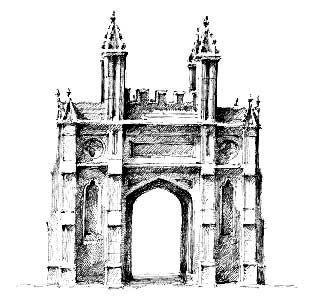


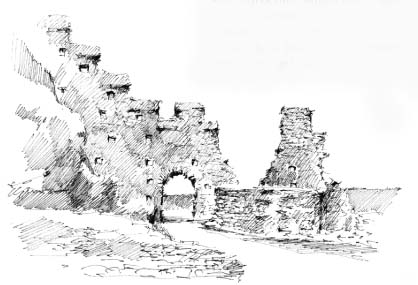



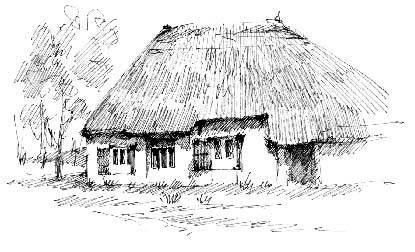


 knew this
knew this